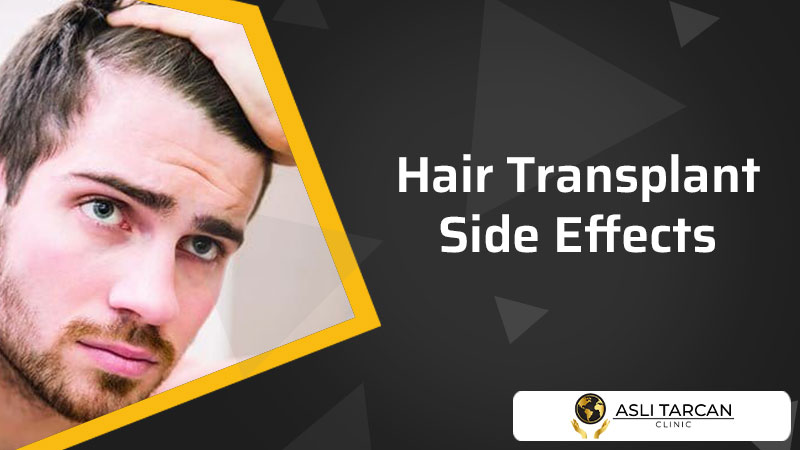Hair transplant side effects, everyone who has experienced hair loss want to restore their hair. Some individuals use medicinal procedures to solve this condition. Hair transplant procedures, which may now be done quickly and painlessly, can be a nightmare for certain patients. According to search engine data, “Is hair transplantation harmful?” is one of the most commonly asked queries. The needle used in the planting procedure is one of the primary causes of anxiety and concern. Because the human head and face are sensitive areas of the body. Some patients may be afraid of surgery because of the needle treatments that will be conducted in this location.
Another source of worry regarding the risks of hair transplantation is the misinformation that has disseminated among the general population. In current culture, there are many erroneous claims concerning hair transplant surgery, as well as a lot of unfounded information. If the essential controls and standards are performed effectively by expert physicians, hair transplant surgery is not a sort of operation that can hurt persons. Is hair transplant surgery, therefore, harmful? The most straightforward response to the question is no.
What Are Hair Transplant Side Effects?
Hair transplant surgery is a type of microsurgery used to improve one’s appearance. Hair transplant surgeries, like any other operation, prioritize the patient’s health. You’ll see that even the most basic operations have the potential for difficulties. Bleeding is the most prevalent negative effect of hair transplantation. This adverse effect, which is dependent on the person’s blood coagulation rate, might cause severe crusting in the hair follicles following the procedure. After hair transplantation, crusting might be visible. Before the procedure, the person’s bleeding and blood coagulation rate should be checked.
The possibility of infection is one of the negative effects of hair transplantation. Every procedure carries the danger of infection. There are two points to consider in order to eliminate the risk that more commonly see in the FUT Method, which includes cutting and sewing: the operation should perform under sterile conditions, and the antibiotics give to the person should use on time and without interruption to prevent infection after the operation.
The creation of a dermoid cyst is an uncommon occurrence. The opening of the channels too deep during hair transplantation and the transplanting of hair follicles more deeply than necessary cause dermoid cyst, which regard as one of the negative effects of hair transplantation. A few weeks following the procedure, permanent skin cysts the size of pimples develop in the hair follicles. Hair follicles must transplant at the proper depth to avoid the production of dermoid cysts.
Causes Of Side Effects After Hair Transplant
Damage to additional hair follicles in the area where hair transplantation perform or where hair follicles gather can also cause peripheral hair loss, which is one of the adverse effects of hair transplantation. This scenario, which generally affects a specific area, is usually only transitory. The danger of this issue has greatly reduced because scalpel and chisel do not use in FUE hair transplantation, which is the most popular procedure in our country and throughout the world.
Damage to the hair follicles during the hair transplant procedure, damage to the hair follicles as a result of a blow to the head, or insufficient feeding of the hair follicles in the transplanted region all contribute to this condition. The failure of the transplanted roots to develop is one of the most common adverse effects of hair transplantation, affecting part of the regional hair follicles or hair follicles. Due to tissue loss in the transplanted region, hair transplantation for wound and burn scar concealment is increasingly prevalent.
Another issue that might arise as a result of hair transplantation is hair that grows in the incorrect direction after the procedure. This hair transplantation issue occurs when the hair transplantation planning is incorrect and the channels do not open at the correct angle. The hair follicles will develop in their natural structure if the channels to open during the planting and planning of the hair follicles open at the proper angles and the front hairline consider.
Hair Transplant Treatment Process
For those who terrified of hair transplant surgery, the needle-free anesthetic procedure. This has used by specialized surgeons in recent years, is a highly suitable operation. This strategy, which devised with those who are afraid of needles in mind, is regrettably insufficient to dispel the public’s misconceptions. The most essential thing to understand about hair transplant therapy is that procedures conduct by specialists offer no risks and that no hair transplant surgery is harmful. However, it has noticed that hair transplant surgeries conducted by persons and organizations who are not professionals in the field cause considerable harm to patients.
It’s important to remember that having a hair transplant do incorrectly or inappropriately might result in major consequences. As a result, before choosing hair transplantation. Athorough and diligent investigation of the doctor or institution that will execute the treatment required. During the treatment procedure, do not deviate from the doctor’s advice. The therapy takes 3-15 days to show benefits. If your condition does not improve, you should see a doctor.
Is Having Hair Transplant Healthy?
Hair transplantation is a surgical treatment that provides long-term benefits that are both safe and effective. This is why the global demand for hair transplantation is expanding year after year. Surgeons became more skilled at this treatment over time. Choose the surgeon with the most expertise and competence for you. Since this will help you get the results you desire. Surgeons have grown quite competent at performing the finest treatment under today’s conditions. An expanding medical industry may also observe in the utilization of new technology and methodologies.
The outcomes of hair transplantation are permanent. The surgeon will devise a treatment plan based on your hair loss condition that will assist you in totally resolving your problem. After three months, the hair will begin to regrow, and the greatest thing is that it will blend in with your natural hairline. Hair will grow in the same direction as the hair you already have. Hair transplantation may consider as a healthy and long-lasting operation for these reasons. When you rigorously follow your doctor’s directions, you will have a healthy healing process as well as a long-term solution.
Can Hair Transplant Cause Death or Less Serious Side Effects?
Some people search “can hair transplant cause death?” on their search engines.
There is no definitive answer to this question, as the research on the subject is inconclusive. Some studies suggest that hair transplant surgery may be associated with an increased risk of death, while other studies cannot confirm this link.

Hair transplants are a safe and effective treatment for hair loss. However, as with any medical procedure, there are some risks involved. There include infection, bleeding, and scarring. To answer the question, “can you die from hair transplant?” In the case of hair transplant surgery, it is possible that the procedure could lead to complications that could be fatal. However, this is rare; most patients can recover from the surgery without serious problems. Ultimately, it is up to the individual to determine whether they are willing to accept the risks of this type of surgery.

Therefore, it is essential to consult a qualified physician before a hair transplant. While the risks are minimal, you should be aware of them. With proper precautions and care, hair transplants can be a successful and safe treatment for hair loss. We hope this article answered your question “can hair transplant cause death?”


